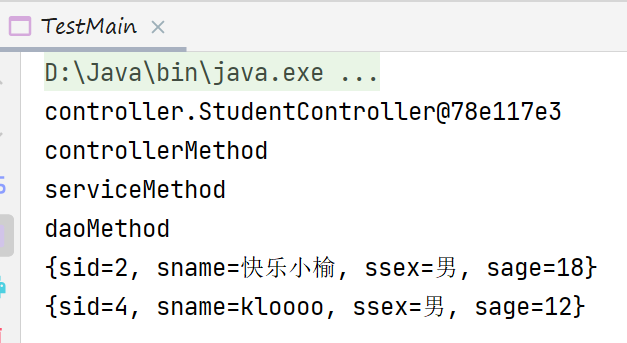Spring中提供新的注解
,用来解决那些类不是我们自己创建的
,但却想要通过注解的方式来管理
1.需要自己写一个类
类的目的是与之前配置文件的目的一致,告知Spring加载初始化的时候该如何创建,管理对象
2.需要在自定义类的上面添加一个描述
添加@Configuration,告知Spring这个类是我的配置,需要让他干活
3.创建BeanFactory工厂
TestMain
package test;import configclass.ConfigClass;import controller.StudentController;import org.springframework.beans.factory.BeanFactory;import org.springframework.context.annotation.AnnotationConfigApplicationContext;public class TestMain {public static void main(String[] args) {//通过扫描注解的方式获取一个工厂对象,改变创建工厂的类BeanFactory factory=new AnnotationConfigApplicationContext(ConfigClass.class);StudentController controller=(StudentController) factory.getBean("studentController");System.out.println(controller);controller.contollerMethod("男");}}
4.自己创建的类中会设计方法
方法是用来创建bean对象 对象通常是别人写好的类型 (例如JdbcTemplate
)
方法上面添加@Bean
如果bean注解中不写id 方法名字就是对象的默认id
5.如果自己写的类中除了自定义方法
还需要告知Spring需要扫描其他包
在自己类上面添加一个注解@ComponentScan(value={} | basePackages={})
6.如果在自己类中创建对象需要一些动态的参数
,可以使用外部配置文件的方式引入
工程内创建一个文件 .properties
在当前主配置类中添加注解
@PropertySource(“classpath:xxx.properties”)
可以在配置类中添加属性
,属性以@Value(“${key}”)
ConfigClass
package configclass;import org.springframework.beans.factory.annotation.Value;import org.springframework.context.annotation.Bean;import org.springframework.context.annotation.ComponentScan;import org.springframework.context.annotation.Configuration;import org.springframework.context.annotation.PropertySource;import org.springframework.jdbc.core.JdbcTemplate;import org.springframework.jdbc.datasource.DriverManagerDataSource;import javax.sql.DataSource;/*** 这个类的目的是用来替代原来Spring核心文件背后的目的* 原来:核心文件---加载文件中的类名字---反射创建对象* 现在:通过这个自定义类创建对象* 通过这个类中自定义方法,实现创建对象*/@Configuration//告知Spring这个类是我的配置,需要让他干活@ComponentScan(basePackages = {"controller","service","dao","domain"})//告知Spring需要扫描其他包@PropertySource("classpath:jdbc.properties")//告知引入文件public class ConfigClass {//类的目的是与之前配置文件的目的一致,告知Spring加载初始化的时候该如何创建,管理对象@Value("${driverClassName}")private String driverClassName;@Value("${url}")private String url;@Value("${jdbcusername}")private String username;@Value("${password}")private String password;//定义一个方法,目的是获取一个对象 jdbcTemplate@Bean(value = "jdbcTemplate")public JdbcTemplate createJdbcTemplate(DataSource dataSource){return new JdbcTemplate(dataSource);}//再定义一个方法,获取一个DataSource类型的对象@Bean(value = "dataSource")public DataSource createDataSource(){DriverManagerDataSource dataSource=new DriverManagerDataSource();dataSource.setDriverClassName(driverClassName);dataSource.setUrl(url);dataSource.setUsername(username);dataSource.setPassword(password);return dataSource;}}
jdbc.properties
driverClassName=com.mysql.jdbc.Driverurl=jdbc:mysql://localhost:3306/newtest?useSSL=false&characterEncoding=UTF-8jdbcusername=rootpassword=cy414ljh212,,,

7.如果主配置中方法过多
,且方法之间有些没有必然关联
,可以将主配置类拆开
变成多个小配置类
,在主配置类中通过@Import(小配置类.class)进行引入

